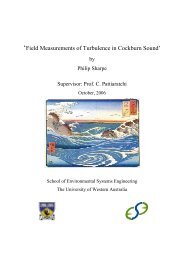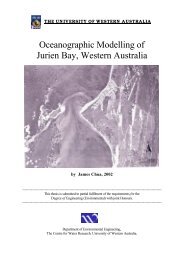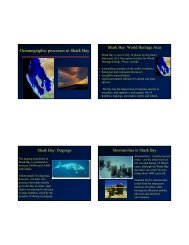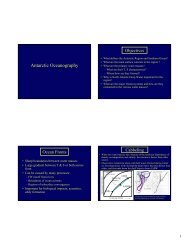Directional Waves in the Nearshore Coastal Region of Perth ...
Directional Waves in the Nearshore Coastal Region of Perth ...
Directional Waves in the Nearshore Coastal Region of Perth ...
Create successful ePaper yourself
Turn your PDF publications into a flip-book with our unique Google optimized e-Paper software.
<strong>Directional</strong> waves <strong>in</strong> <strong>the</strong> nearshore coastal region <strong>of</strong> <strong>Perth</strong>, Western AustraliaHuey Jean TanHorikawa (1988). However, <strong>the</strong>re are <strong>in</strong>herent drawbacks to <strong>the</strong>se methods as <strong>the</strong>y sometimesestimate erroneous directional spectra due to <strong>in</strong>accuracies (e.g. <strong>in</strong>accuracy <strong>of</strong> <strong>the</strong> cross-powerspectra). Hence, <strong>the</strong> maximum entropy pr<strong>in</strong>ciple method (MEP), Bayesian directionalspectrum estimation method (BDM) and extended maximum entropy pr<strong>in</strong>ciple method(EMEP) were developed to mitigate <strong>the</strong> drawbacks <strong>of</strong> conventional methods, and have s<strong>in</strong>ceprovided a powerful means for reliably estimat<strong>in</strong>g an accurate directional wave spectrum(Hashimoto 1995).The MEP method derives <strong>the</strong> directional wave spectrum us<strong>in</strong>g location-dependent threequantitymeasurements related to random wave motion (eg, pitch-roll-and-heave data). Itprovides <strong>the</strong> directional estimates with a higher resolution than that obta<strong>in</strong>ed by <strong>the</strong>conventional methods, however it is not a general method because it can only utilise a threequantitymeasurement and does not consider errors <strong>in</strong> <strong>the</strong> cross-power spectra (Hashimoto1995). The BDM is a general method because it can utilise multi-quantity measurementsobta<strong>in</strong>ed from mixed <strong>in</strong>strument arrays and provide <strong>the</strong> highest resolution whilst provid<strong>in</strong>g areliable and robust method for estimat<strong>in</strong>g <strong>the</strong> directional spectrum and cross-power spectracontam<strong>in</strong>ated by errors. The ma<strong>in</strong> drawback <strong>of</strong> <strong>the</strong> BDM is that it utilises a time-consum<strong>in</strong>giterative computation and cannot always be used for three-quantity measurements (Hashimoto1995). The EMEP method conta<strong>in</strong>s <strong>the</strong> benefits <strong>of</strong> <strong>the</strong> BDM and can use three-quantitymeasurements and yield equivalent results <strong>in</strong> a shorter time (Hashimoto 1995). More<strong>in</strong>formation on <strong>the</strong> EMEP method is provided <strong>in</strong> Appendix A.16 Literature Review













